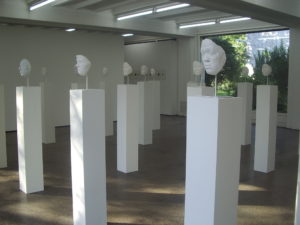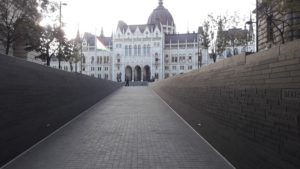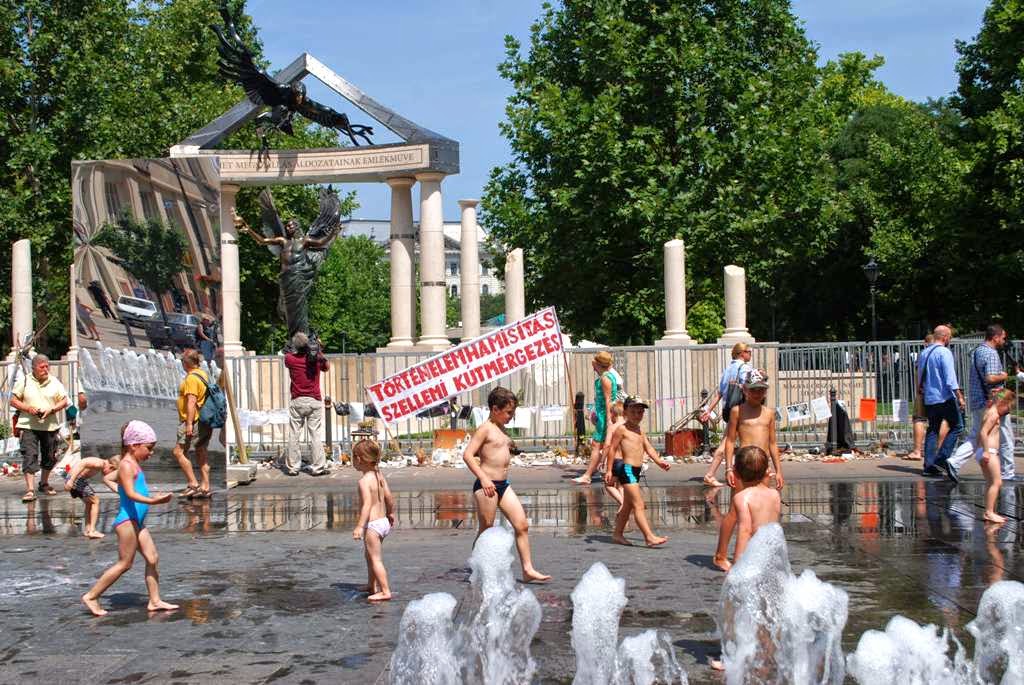A Counter-Monument to Female Victims of Wartime Rape: An Interview with Edit András
A new memorial project in Budapest, Memory of Rape in Wartimes: Women as Victims of Sexual Violence, will commemorate female victims of wartime rape, while establishing a culture of dialogue around rape and violence in Hungarian society and the region. Initiated by the General Assembly of Budapest in January 2020 and to be completed in 2023, the project goes against the grain of the practices of the current Hungarian government’s illiberal system of erecting nationalist monuments and statues without public input, through an open, democratic process that includes artists, historians, scholars, an international jury, and representatives from public institutions. In the following interview, art historian and critic Edit András, who is a member of the project’s Permanent Committee, discusses the origins of the memorial, the process for vetting proposals, and how contemporary public memorials to collective trauma should be conceived.
Susan Snodgrass: How and when did the memorial Memory of Rape in Wartimes: Women as Victims of Sexual Violence originate?
Edit András:The General Assembly of Budapest, where the parties that are in opposition to the ruling Fidesz are in majority, unanonimously adopted a resolution to set up a Monument to Women Raped in War, as it was initially named, in January 2020. The trigger was certainly Andrea Pető’s book Speaking about the unspeakable: Sexual violence during WWII (Budapest: Jaffa, 2018.) Although it was the first comprehensive research published on the topic, it did not come out of the blue. Several attempts had already been made to break the silence around wartime rape. The feature film The Prosecution by Sándor Sára made in 1997 could not break the taboo, as its public screenings was stopped quite soon after its release. Fruzsina Skrabski’s documentary Silenced Shame (with Pető’s participation as an expert consultant) has reached its audinces and is still available for a wider public online. Other factors have also contributed to the decision taken by the city administration. The “Me Too” movement, which reached Hungary as well, provided a momentum by which the topic of wartime rape could reach public attention. The pronouncement also coincided with the intention of the Municipality to improve and create a clearer sitution in the public space of Budapest. Once public spaces were emptied out of socialist monuments, a new terrain opened up for symbolic politics as well as for “decorating” these spaces. The earlier institutions in charge of public monuments were dissolved, creating total chaos. The government with the right-wing Fidesz party majority, which has been ruling since 2010, reerected pre-socialist monuments and put up new ones without transparency, without open calls, competitons or any consensus, in order to rewrite history serving its own interest. “Statue mania” also gripped several districts of the capital. As a result, public spaces are filled with statues and monuments carrying the current ideological agenda on one hand, and tasteless, “cute” genre statues on the other. A “no vacancy” sign for monuments could be placed in Budapest, especially on the Pest side of the city. The Municipality felt an urgent need to seriously reconsider this, and aimed to return to clear and transparent processes, competitions, and professional expertise. As a preparatory phase, the Municipality initiated a discussion in the form of an interview series about the recent state of affairs of public spaces in the online art journal Artportal. Some professionals went as far as arguing for a total statue embargo. That was the moment when a Permanent Committee of the project was set up in order to guide and facilitate the process.
SS: There are several individuals and institutional partners all working to realize this project, including a jury who will review proposals. Can you talk more about the process for selecting an artist or artists whose work will speak to issues of personal trauma, remembrance, and forgotten histories? Is this an international competition?
EA: There are two institutions involved in the project, the Budapest History Museum (BHM) and the Budapest City Archive (BCA). BHM’s Department of Public Art will implement the competition and jury process, while the Budapest Gallery, a branch of BHM, will organize an exhibition of the models of the shortlisted proposals. At the time of the inauguration of the future memorial, a comprehensive exhibition will be shown at the Kiscelli Museum, another branch of BHM, with a twofold agenda: to provide an overview of the visual representations of violence, and to present a comprehensive history of local practices surrounding monuments. The BCA hosted the lectures and runs the website, as well as collects documents and archival materials.(The participating institutions are represented by directors Noémi Népessy (BHM) and István Kenyeres (BCA) in the prepatory board, which also includes independent experts, historian Andrea Pető, and two art historians József Mélyi and myself. The Municipality is represented in the meetings by Judit Bor, head of department of culture and Gábor Kerpel-Fronius, deputy mayor.) The advisory panel extends the scope of the committee with the perspectives of the city’s architect in chief and landscape architect, representatives of civil organizations, artists, and historians.
We initiated an international open and blind call, the deadline of which was October 15, 2021; thirty-five applications were submitted.The jury members will review all the bilingual proposals, this will be followed by an online forum to discuss the propositions and select a shortlist of candidates. The final stage of the jury process – selecting the proposition to be realized – will preferably be a face-to-face onsite meeting in Budapest. The jury has two international members – James E. Young, prominent American scholar of memory and memorilization and Serbian artist MilićaTomic – and the Hungarian members come from different fields of study, bringing different perspectives to the memorial. The one civil member of the jury has been selected from eleven candidates, after reviewing their motivation letters.
SS: Is the monument to be a marker to women who were rape victims during the Second World War, as the website suggests, or to all women, past and present, who have been sexually abused during wartime? Is the monument to Hungarian women or female victims throughout Eastern Europe?
EA: It is always a major dilemma of all memorial sites: to whom is it to be dedicated, and how widely the victimhood is to be understood. In our case, the starting point was the aim of giving recognition to the memory of the victims of rape during WWII, which in Hungary is associated with Soviet soldiers raping Hungarian women. However, that interpretation would not only fall into the trap of nationalism, to blame the enemy and heroize our own, but also be only part of the historical truth. The research made it obvious that there were also German soldiers among the sexual predators during WWII, but that women on the other side of the front suffered sexual atrocities committed by Hungarian soldiers as well. Furthermore, patriarchal nationalism is the structure that nurtures sexual violence in the form of raping mothers and daughters of the enemy as a tool for inflicting final damage on the enemy through dehumaliation and degradation. As such, sexual violence against women is part of all wars. That is why during the prepatory procedure we changed the name of the project to Memory of Rape in Wartimes: Women as Victims of Sexual Violence.
One might say that WWII is a distant past event, and although the victims are no longer among us their memory still haunts us. The victimhood of these women and their suffering have never been acknowledged nor included in our memory culture – this is a silenced, hidden part of history. However, genocide in Srebrenica and the mass rape of Muslim women happened in close proximity, just two decades ago, so sexual violence is not something we can bury with the past. Thus, the memorial project does not designate an exact time or place it relates to, it aims to generate solidarity among actual and potential victims, as well as warn against sexual atrocities that accompany any war.
SS: What is the public reception to this project? Has there been involvement with local citizens and community members?
EA: The preparatory period coincided with the pandemic, so the lectures given by experts of different aspects of the project (history of rape, visual representation of violence, psychological effects and working through rape, history of monuments and memorials) were mostly delivered online, without direct contact with the public. However, it reached a lot of people as we can detect from the number of likes and people who followed the lectures. The same applies to the video interviews, conducted with international experts on memory (Aleida Assmann) and memorialization (James E. Young, Michael Rothberg), as well as with artists who work in public space (Eduard Freudmann and Ilona Németh). Pető’s book is widely discussed as well.
Concerning the public memorial, we invited a civil member into the jury, and we plan public discussions connected to the display of the models of the shortlisted proposals. In comparing our memorial to other memorial projects, the difference is that the majority of female victims are no longer living; even if they are, they do not wish to expose themselves. Due to the nature of rape, it is still a taboo subject for public discussion, with shame on the side of the victims and victim blaming still operating in society. Furthermore, it is not possible to designate a specific place or certain neighborhood where the crime could be connected.
SS: Has a site (or sites) been chosen for the monument? And when will it be unveiled?
EA: The BHM together with the Municipality of Budapest is in charge of designating possible sites for the memorial. Budapest is divided into districts, and there are territories in the capitol that are under the control of the Municipality, while others belong to the relevant districts. Thus, the Municipality can offer places that fall within its authority. Five places were recommended to the artists to plan a public work. All of them are located on the Buda side of the capital. And as I said earlier, the Pest side is already overcrowded with statues, memorials, and monuments; there is almost no vacancy for new public works there. Still, there is a possibility for the artists to choose a site other than the places offered by the commissioner. If they can firmly argue for the place, it may be obtained for this purpose. The places that were offered are all well researched, some of them are historically loaded sites. The inauguration is planned in spring 2023.
SS: Other components of this memorial include a library of texts, recorded talks and other resources related to war and human violence, as well as an open call for personal stories and archival materials. Where will this material live once the memorial has been completed?
EA: The project website will still be live after the memorial is completed, for a minimum of a few years. Later, all the materials will be preserved by the Budapest City Archive and made available for those who are interested.
SS: This project seems quite unique as there are very few monuments to women, particularly those addressing the trauma of sexual violence. One example that comes to mind is Doris Salcedo’s Fragmentos (2018), a memorial site to female victims of physical and sexual abuse at the hands of the Columbian guerrilla group FARC. Or perhaps, Rachel Whiteread’s Nameless Library (2000), a Holocaust memorial in Vienna. Both are counter-monuments that commemorate uncomfortable, often invisible histories –victims versus heroes. What commemorative practices and models are you looking at?

Sanja Ivekovic, The Women’s House, multimedia installation and workshop, 1998 – ongoing. Image courtesy and copyright Sanja Ivekovic.
EA: As we were aware that there is a huge gap between how people generally consider public monuments and the contemporary art practice of monuments and memorials, our lecture series included an introduction to the origin and function of monuments in the 19th century, the transformation of French statue mania into the visual language of nationalism, and the use of monuments by the Soviet regime for socialist ends. Contemporary art practices were also introduced and a lecture was dedicated to the concept of counter-monuments through Holocaust memorials. In order to show the wide variety of memoralization of these victims, we researched and introduced monuments from China, the United States, Uganda and Kosovo that were dedicated to sexual violence against women, whether they were realized in a traditional form (comfort women statues from around the world) or used the language of contemporary art in accordance with what we consider relevant public art models today. We also presented subversive practices such as Lady Rosa of Luxembourg (2001) by Sanja Ivekovic, who generously allowed us to use pictures from her Women’s House series (1998 – ongoing), which deals with violence against women, as the face of our website.(Conceived by Sanja Ivekovic in 1998, The Women’s House project is an international collaboration devoted to violence against women realized as site–specific installations and printed materials (texts, postcards, posters). On occasion, it is also presented through press conferences and video screenings. The first phase of the project consists of establishing contact with a local shelter for abused women where the artist conducts a workshop in close collaboration with the women living in the shelter. During the workshop, casts of the women’s faces are produced along with brief personal stories written by the women themselves. The resulting masks and texts are then installed according to the artist’s concept in a specific exhibition space. To date, collaborations have been made with The Autonomous House in Zagreb, The Fraenhaus in Luxembourg, The Bangkok Emergency Home in Bangkok, Safe House in Peje, Kosova, Casa per le donne in Genova, The Center for Women and Children in Belgrade, Vie-Ja in Utrecht, and Mor Cati in Istanbul.) Other examples include Jenny Holzer’s Lustmord project (1993) and her Untitled (1996) ephemeral memorial work screened onto the Monument of Battle of Nations, Leipzig, that confronted the hero, the core concept of nationalism as opposed to women’s role within the nation-state. In the open call we asked for the “production of a feasible work of art that employs up-to-date visual language and can be meaningful in an international context. The Host would prefer a work of permanent public art, but ephemeral works may also be considered.”
SS: Given the rather complicated history of socialist monuments in Hungary and elsewhere in Eastern Europe, many of which were either toppled or removed to outdoor reliquaries (such as Budapest’s Statue Park) after 1989, how will this project address public space and monumentality divorced from this history?
EA: The whole problematics of socialist monuments is gone with the wind, at least for now; their memory has literally been buried, as well as the objects themselves, by the right-wing populist, illiberal Orban regime. The program of the Fidesz party that was reelected in 2010 for the second time (the first Orban government was in power between 1998-2002, followed by a socialist-liberal period) aimed at “real political transformation.” The goal was to remove the “ex-communist elite” – a label referring to all associated with cosmopolitan, liberal, international thinking – replacing it with a new elite representing a traditional, conservative, Christian, and national agenda in order to (re)establish national sovereignity and reclaim past national “glories” in which art and culture were to play a crucial role. A full-scale attack was carried out on the cultural sector. Step by step, the cultural sphere and its institutions were invaded or deprived of funds even for continuing basic operations, while alternative institutions were established and stuffed with huge subsidies. Since 2010, cultural politics has been replaced with identity politics and symbolic politics, which targeted the public space.
The last remaining socialist monument, Monument for Soviet Heroes, is dedicated to the Great Patriotic War and to those Soviet soldiers who died in the siege of Budapest and were buried underneath the monument. It is still in Freedom Square due to diplomatic reasons. By erecting the infamous monument Memorial for Victims of the German Occupation on the opposite side of the same square in 2014, the regime killed two birds with one stone. The monument, erected without any competition or public consensus, did not simply visualize the core political statement of Fidesz but also converted the meaning of the last Soviet monument. According to the rethoric, inserted into the Constitution and introduced by the new Fidesz majority parliament called “Basic Law,” Hungary lost its sovereignty as a result of two consecutive occupations of the country: first by the Nazis, second by the Soviets. The symbolic politics of Freedom Square is in line with this rhetoric, thus the Memorial for Victims of the German Occupation transformed the Monument for Soviet Heroes into a visual sign of occupation. I would call this act “conceptual iconoclasm.” Even those public monuments were designated enemies of the nationalist symbolic politics and had nothing to do with the par excellence socialist realist monuments. The memory of the socialist past, together with the socialist vision of modernity, had to be erased completely and the public space had to be transformed according to the historical identification with the double victimhood of the country.

Memorial of the National Alliance, in front of Parliament, Budapest, Hungary, 2020. Photo: Edit András.
If the period from March 19, 1944 to May 2, 1990 was rendered illegitimate in the new Basic Law, the public space surrounding the Parliament, representing the national power center, had to be transformed accordingly. Thus, Kossuth Square around the Parliament was meticulously reconstructed to how it looked in 1944. Kossuth Square offers a time travel to the interwar period, the ideology of which is appropriated by the present regime. Discursive hegemony in public space was crowned by the newly erected Memorial of National Alliance nearby. The memorial does not mention the Trianon Peace Treaty. However, its symbolic site, enormous size with symbolic numbers (erected for the 100th anniversary of the treaty in 2020), and names of the cities and villages given in the time of extreme “magyarization” in 1913 carved into the granite walls and slope of the monument that descends into the “grave of the nation,” all refer to Trianon. The memorial is a visual crystallization of the regime’s mission to create ethnic cohesion on the basis of collective grieving. Thus, it is not the history of socialist monuments that our project should address, but ethnic nationalism and its megalomaniac public invasion. That is why our project is very cautious not to fall into the trap of nationalist imagination conceiving women as heroines who sacrified themselves for the nation, but rather wishes to shed light on how war victimizes women.
SS: What is the state of contemporary practices in public art and monumentality in present-day Hungary and Eastern Europe? How will this memorial address current cultural discourses and debates?

Living Memorial, personal objects placed in front of the Memorial for Victims of the German Occupation, Freedom Square, Budapest, 2014. Photo: Gabriella Csoszó.

Living Memorial, personal objects placed in front of the Memorial for Victims of the German Occupation, Freedom Square, Budapest, 2014. Photo: Gabriella Csoszó.
EA: The best counter-monument in the region is the Living Memorial (2014), a reaction and response to the Memorial for Victims of the German Occupation. It was actually initiated by artists Csaba Nemes and Szabolcs KissPál, among others, which is often forgotten as it is has been taken over by historians and activists. It generated public debate about the role of Hungary in the Holocaust, the responsibility for which is totally denied in official history. People placed personal objects and photos near the monument and instigated discussions that are still going on. Otherwise, parallel to the monopolization of the public space, contemporary artists were crowded out. The European project Private Nationalism (2015-16) initiated by Hungarian artist Rita Varga (in which I also participated as a theoretician and curator), spawned lots of critical works addressing issues of nationalism, not just in Hungary but in neighboring countries as well. The exhibiton was on during the second term of the Fidesz government and was silenced in the official media. The political and cultural climate changed so much in favor of the new conservative elite that I doubt the Private Nationalism exhibition could be shown today. One can barely find artists who address political issues; the contemporary art scene became frighteningly apolitical.

Imagined Communities, Personal Imagination, part of Private Nationalism, Budapest. Installation view of the exhibition with works by Ferenc Gróf, Gluklya, Little Warsaw, and Martin Piacek, at the Kiscelli Museum, 2016. Photo: Kiscelli Museum.
As for the planned memorial, it is too early to predict how it will function or its reception. In Hungary’s current society, the authoritarian regime promotes a Christian-conservative agenda and “gender ideology” is conceived as a threat to this identity and family model, so much so that even the word “gender” is banned from the vocabulary. Likewise, Parliament has refused to ratify the Istanbul Convention, the first international instrument for combating violence against women and domestic violence, and the country’s most recent anti-LGBTQ law formulates discriminatory restrictions against sexual minorities. Thus, the very existence of a memorial dedicated to women raped during war is a strong statement in itself. Nevertheless, it most probably will generate debates and will make waves in the stagnant water of memory culture, history, and public art in Hungary.
SS: You once wrote: “In the urgent need of empathy, of public narration, of public participation in memory work as opposed to statues and the public sphere being used and abused in the hands of political forces, artists could serve as agents of reconciliation and social healing.” Can you expand on that, particularly within the context of Memory of Rape in Wartimes: Women as Victims of Sexual Violence?
EA: There are two different ways to initiate monuments and memorials, and both can be legitimate: they can be initiated either from “above” or from “below.” Although in our case the initiative came from “above,” and is so strongly connected to the sensitive nature of the crime that it is extremely difficult for women to even talk about it, this is not an arbitrary process. It aims to be a transparent, professional, and open process that is based in a long and thourogh preparatory phase. The call wants to opens up possibilities for artists to help society cope with this memory. It is emphasized in the call that the goal is to “create an opportunity for participation, reflecting on historical and personal tragedies as well as the suppressed nature of the topic by means of symbol creation and spatial arrangement, thereby facilitating coping with the trauma on the level of the individual and the society.”
I strongly believe that in our turbulent and troubled times, artists are the agents not just of reconciliation and social healing but of showing a way out of the multifaceted crisis. This is exactly the reason why I accepted taking part in this time-consuming and strenuous project. I do hope the result of the competition will justify this belief.
This interview took place via email in October 2021. It has been edited for length and clarity.
This article is part of the Special Issue Contemporary Approaches to Monuments in Central and Eastern Europe. You can find links to the other articles in the special issue below:






